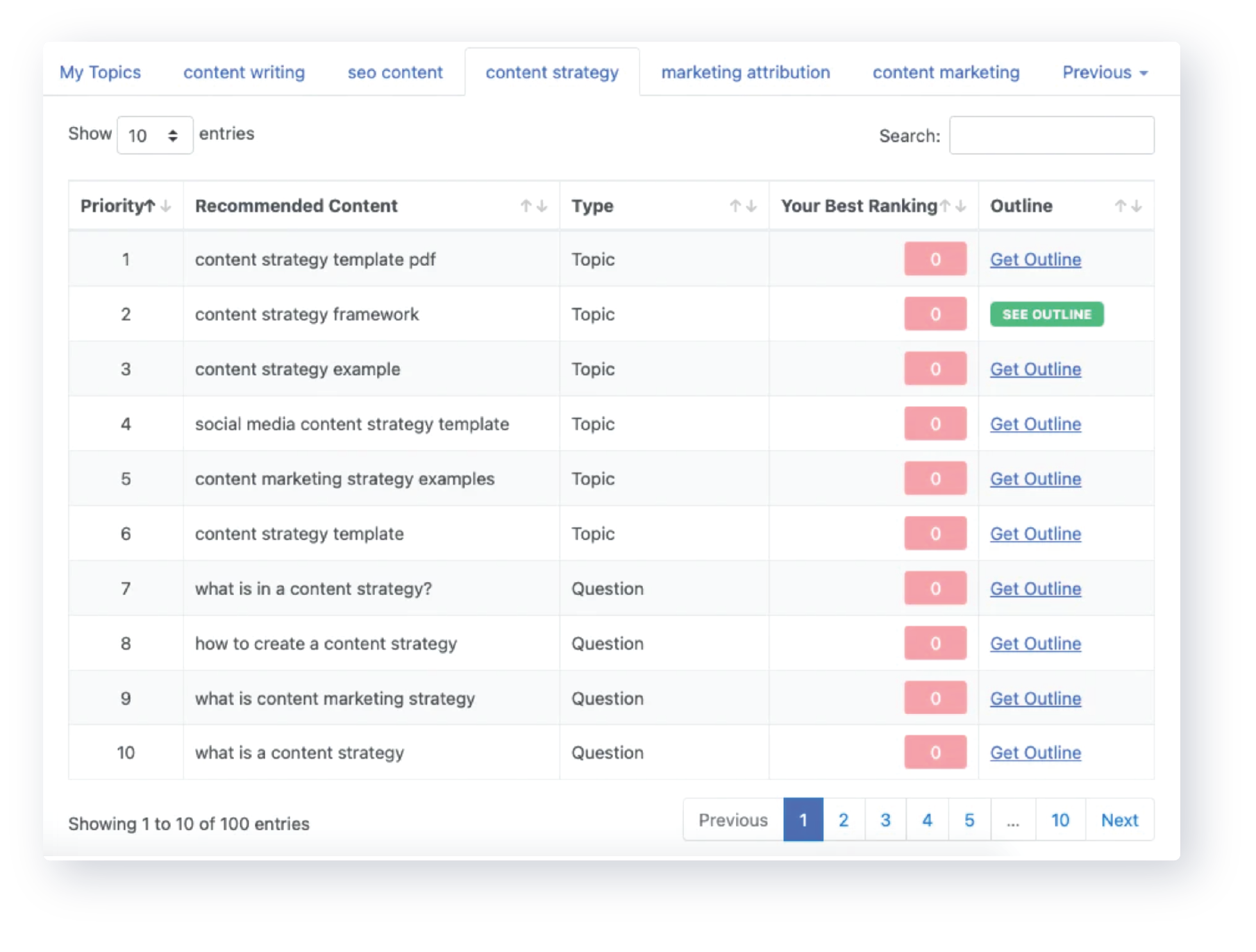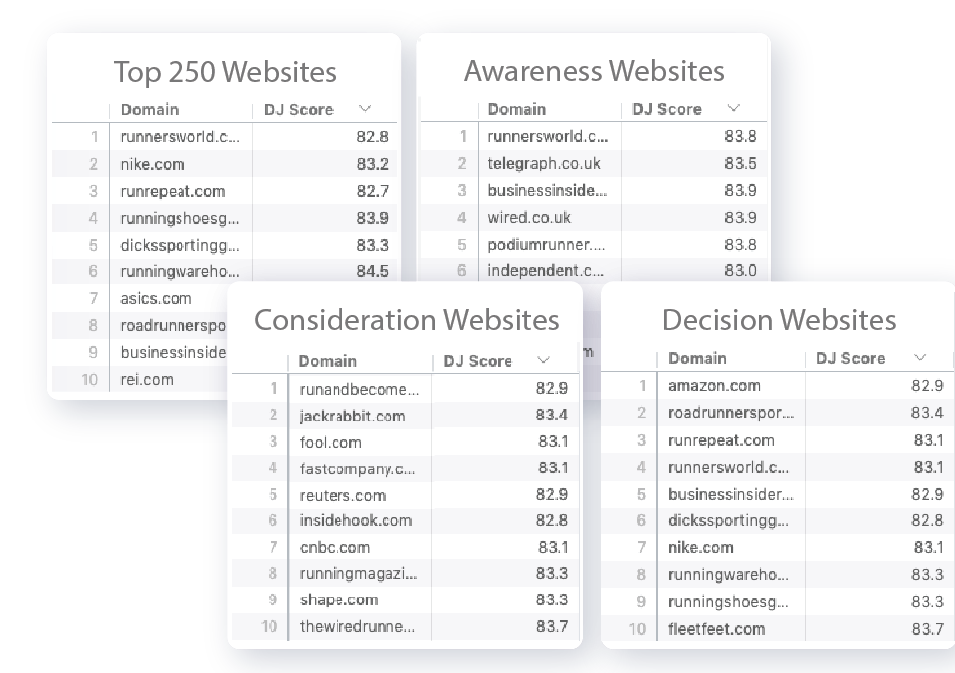See Insights in Action
We use DemandJump recommendations as our digital to-do list. We love going in and seeing the recommendations and knowing what to do next.
JoLynda Wilson Marketing Director @ IWC
By embracing DemandJump's approach to SEO, we have been able to increase our organic rankings within just 2 weeks of implementing recommendations. This helped us see a 22% increase in organic search month-over-month.
Robert Jacko Vice President Digital Marketing @ Homage
DemandJump has become a crucial extension of our marketing team, providing game changing insights to fuel and propel all aspects of our digital marketing efforts. The DemandJump platform is a must have, we are seriously impressed.
Tim Lavinder Director of Ecommerce @ Hotsox
We used to spend hours looking for insights in dozens of tools and reports. Now we log into one place to find out what customers are doing and how to meet them where it matters most.
Zach Roop Digital Marketing Manager @ Dometic
We use DemandJump recommendations as our digital to-do list. We love going in and seeing the recommendations and knowing what to do next.
JoLynda Wilson Marketing Director @ IWC
By embracing DemandJump's approach to SEO, we have been able to increase our organic rankings within just 2 weeks of implementing recommendations. This helped us see a 22% increase in organic search month-over-month.
Robert Jacko Vice President Digital Marketing @ Homage
DemandJump has become a crucial extension of our marketing team, providing game changing insights to fuel and propel all aspects of our digital marketing efforts. The DemandJump platform is a must have, we are seriously impressed.
Tim Lavinder Director of Ecommerce @ Hotsox
We used to spend hours looking for insights in dozens of tools and reports. Now we log into one place to find out what customers are doing and how to meet them where it matters most.
Zach Roop Digital Marketing Manager @ Dometic
We use DemandJump recommendations as our digital to-do list. We love going in and seeing the recommendations and knowing what to do next.
JoLynda Wilson Marketing Director @ IWC
Trusted by Brands Around the World
Consumer Insights
Find out what your target audience cares about for any category, product, or topic, with the click of a button.
Know What to Write About
Eliminate the guesswork and align your content strategy to actual user behavior.

Know Which Keywords Matter
Get a prioritized list of the exact keywords that matter for your audience.

Automatic Customer Journey Map
Automated customer journey mapping tells you the keywords, questions, websites and videos your audience consumes for each stage of the buying process.

Get Free Consumer Insights Now
SEO Content Strategy
Content strategy is quickly becoming a new buzz phrase in marketing. There's a good reason for this — you need a content strategy in order for any of your content to contribute to the achievement of your business goals. Content strategy is the overall plan that you have for where your communications will be and which channels you're using, but it's more than just that. It's all the data and intelligence related to your ideal market and how you can build a real relationship with them based on value. It requires consumer insights to understand what your target audience cares about, and what content they want to consume along their path to purchase.

Content strategy is a wide topic. Done well, it helps you position your brand and forms the basis for your marketing momentum. But we're not just talking about content strategy in this guide. We're talking about content strategy for SEO.
An SEO content marketing strategy is all about your search engine optimization. It makes up a good portion of your content strategy, and there's a difference of opinion on which is more important. At DemandJump, we believe that they are equally important and work together.
Your content strategy is your overall inbound marketing approach that uses social media, email marketing, blog content, landing pages, and any written materials to engage your audience and offer value. SEO content uses specific SEO techniques to make sure that the search engines properly categorize that content so that you can be more easily found by the people who need you.
Some content strategy experts have said that great content developed through a robust content strategy helps the search engines organically place you in the right categories without an SEO strategy. This might be true, but your SEO content strategy helps you to research your position, topics, and keywords. It informs what you write. It also informs how you build your web presence to increase your page rank, which is important if you want to be found. SEO isn't simply about the words you choose. It's also about tailoring your strategy to target the right audience and helps you strengthen your credibility with the search engines to get you in front of that audience.
SEO is often thought of as simply incorporating keywords into your content. While your target keywords and keyword research are part of it, that's only a small slice of SEO content strategy.
The Basics of Content Strategy
Content strategy is the business plan for your inbound marketing endeavors. It uses SEO content strategy, SEO best practices, social media marketing, email campaigns, and a variety of other techniques that fall under the umbrella of your online content. But it's not just the content itself.

The real merit of your content strategy is in the strategy. This is why we compare content strategy to a business plan. The heart of your content strategy starts with understanding your marketing position, who your target audience is, what they need, where they are, and how your offerings are the best fit for them.
This is not your grandfather's advertising—direct, forceful, and overt. Content marketing is about offering value and building relationships, not a hard sale.
There are many parts to a content strategy and the ones you choose to include are unique to your business and ideal market. For instance, the social media portion of your content strategy should target platforms where your target audience is comfortable, but that doesn't mean you need to use EVERY platform where your audience might spend time. You should start with one or two that you know your target audience is active on and that your team has the time and expertise to be successful in, then expand into others.
Components of a Content Development Plan
Market Positioning/Branding
The central part of your content strategy is in determining where you are in the market. What areas does your business excel in? What areas can you improve? What value do you provide your customers with? This informs what you want your brand to be known for, who your ideal market is, and who your competition is.
Buyer Personas
A buyer persona describes what your ideal customer looks like, what their pain points are, and why they might use your product or service. Developing these personas helps you to create content that your ideal customers will find valuable. In this way, you're attracting the right audience to your content, rather than trying to convince a wide audience to purchase.
SEO Strategy
Your SEO strategy includes keyword research and other techniques to help your content rank higher in search engines.
Social Media Marketing
Social media marketing offers the ability to directly connect with your audience in a personal way while providing you with additional channel(s) to promote traffic to your website and offerings. This will help increase traffic to these spots.
Pillar Pages
Pillar Pages are in-depth pieces of content that provide a broad overview of a topic you choose. They aim to educate your readers on that topic and don’t necessarily aim to sell something throughout. These are pieces that often provide value for your reader, such as "how-to" or guide pieces
Email Campaigns
Email marketing still offers excellent conversion rates and may be one of many techniques you use in your overall strategy. They can be a great way to promote new products or services, provide more background on your company, or build connections with your customers.
Video
Video content may be used on your website and channels, like social media platforms or Youtube. Live streaming video has also grown in popularity on sites such as Facebook and Instagram. Webinars work well to educate your target audience and to keep them coming back to learn more.
Paid Advertising
You may use paid advertising to help promote your company, new product launches, or specific offers and events.
Analyzing Your Data
Whatever marketing campaigns you conduct, regularly assessing your analytics helps you to see the ROI, plan future campaigns, and pivot when some measure isn't working as expected.
As you can see, there are a lot of different techniques. You may not use all of these. You might, after checking the analytics, decide to change your approach when needed.
Elements of SEO Strategy
The elements you use to develop your SEO strategy can evolve as new techniques become available. SEO is already a very wide discipline. Elements of an SEO strategy might include content creation, link building, optimizing for web crawlers, and mobile optimization.
The elements you use to design your SEO strategy all serve to make your site more attractive to the search engines. To do that, you need to understand two things:
- The search engines want to provide the best experience for the user.
- Working with the search engine also helps your website to attract your target audience.
The algorithms that search engines use are designed so that the user is more likely to find the material that's valuable for them. This is why old methods, like keyword stuffing, don't work. In fact, keyword stuffing is penalized by search engines. It's not enough for you to make sure that you use the right keyword phrases. When you design content, you should be designing it to answer the questions that the user is most likely asking. You want your content to offer convenient information on the topic that the user is interested in. Google’s helpful content update highlights just how important writing educational content by people, for people, truly is.
Again, SEO is not only about the keywords you're using. It's also about the way that your site functions, how much content you have and how often it's updated, and the number of reputable websites that link your content. Search engines, like Google, want to recommend websites that show credibility. To get that proven track record, you need to provide quality content that's on target for your audience. The better you maintain your site and the more often experts link to your content, the higher your page rankings will go.
User Experience
This is one of the key things that you should be concerned with in your SEO strategy. It doesn't do your business any good to have an audience find your website and leave right away. This can be caused by the content not matching the search terms or using search terms that aren't quite right for your ideal audience. It can also be caused by the design of your website. If it's challenging to use or the page and images won't load quickly, you're likely to lose people.
Keyword Research
It's important that you're clear about which keywords you want to concentrate on. This means researching the phrases, how often they're being used, and which keywords your competitors are using. It's also important that you understand your own marketing position and buyer personas in order to develop a keyword list that is buildable. This means that you use terms that your audience will search for but that also relate to what your business does and can offer. DemandJump can help you create your keyword list as well. When you research keywords, make sure you're including voice search in your data. A lot of users will find you through their AI, and voice search is often much different than the keywords we manually type into a search bar.
Use Best Practices for Title and Tags
There are best practices for developing a Title, page/post description, and tagging your post or images. It's important that you pay attention to these character limits. For example, the description limit helps you to understand what the searcher is able to read when they see your site recommended in search. The short sentence or two that follows the URL can often convince the searcher that they want to read more. So it's important that it's both within the word count and accurate. (Hint: the meta description is usually about 155-160 keywords!)
URLs Matter
You want your URL to be easy to recognize and to categorize your content. A good rule of thumb is to use the title of your content in the URL.
Mobile Optimization
Mobile optimization is no longer optional. In fact, 86% of Americans use digital devices to get their news, according to Pew Research Center. So, make sure that your site is easy to use on a mobile device because the number of people reaching your site by smartphone is far greater than the number of people who visit through desktop.
Local Search
If you're a brick and mortar business or a business that caters to a geographic location, use those geographic terms in your content.
Claim Your Business on Google
This is effective, will increase your ranking, and will give you an extra way to reach searchers who are looking for your services nearby.
Keep Track of Reviews
If your business or services are on Yelp or other review sites, it's important that you pay attention to those listings and respond to reviews, when possible. Make sure to remain positive even when responding to negative reviews. Prospective customers won’t want to do business with someone who gets angry at them.
Audit Website Performance
You should know how your site is loading, whether it's getting crawled, and when there might be any broken links that can damage the content or your credibility. For newer sites, you may not need a full audit. A thorough quality check might suffice. It is important that you schedule testing of site performance on a regular basis. You might be surprised how often some small browser update or template change can impact other aspects of your performance.
Your SEO strategy is ever-evolving
Look at this as a long-term investment of time. Each of the elements that you use in your strategy should be assessed on a regular basis to make sure you're hitting the benchmarks you set. You may also want to add new elements as they become available or make sense. For instance, a business that is all online and has clients that all over the country or world won't need to use geographic SEO elements. However, if you added services to your business offerings that were location-specific, you might need to revisit adding those elements.
Search Engine Optimization Techniques
There are many types of SEO techniques that you might use in your SEO strategy. In fact, there are so many possible techniques it would be near impossible to use them all. For many marketers, it's a matter of finding the techniques that work best. Because SEO is always evolving, it helps to stay current on new techniques. You might test out something and decide that it isn't worth the ROI. You might also find techniques that work far better than you anticipated.
Techniques fall into two categories:
- White Hat SEO
- Black Hat SEO
White hat SEO is the term for the techniques that are recommended. They’re honest techniques used to make your good content more valuable to consumers and easily understood by Google. Black hat techniques are the ones that search engines do not recommend. They’re deceptive and designed to game google’s algorithm. In fact, black hat techniques can get your website heavily penalized, which might include removing it from search entirely. It's pretty easy to keep these two types of techniques straight. It's like the old Westerns where the good guys wore white hats and the bad guys wore black hats.
White hat techniques are ethical. Building website ranking and credibility takes time and consistent effort. The search engines realize this and they reward businesses who build credibility the right way and make their content convenient for the searcher.
Black hat techniques are unethical. These are ways to trick the search engine into ranking the business higher than it should. This might include keyword stuffing, buying links, and other practices that promise to raise the page rank quickly to increase traffic. Stolen content can be another technique that nefarious sites use to increase their views.
We don't need to point out that black hat techniques should be avoided at all costs. The penalties aren't worth the short term traffic and it can damage your business reputation.
Now, we've talked about techniques to avoid, let's talk about some techniques that work well.
SEO Content Techniques That Work
Update for the Current Algorithm
Google updates its algorithms fairly often. At the time of publishing, they recently launched a search spam update which improved how well Google detects spam. This could impact how your site ranks if you use any of the black hat techniques we mentioned above. Older techniques are still relevant, but make sure that you understand the new changes and how they impact your content. Google has an ongoing list of their recent updates you can reference.
Cluster Content
Pillar pages, sometimes called cluster content, have been a highly recommended SEO technique for the past few years. If you're not using pillar content and organizing your topics, it's a technique that will definitely improve your SEO. DemandJump can help you create Pillar-Based Marketing strategies to improve your organic traffic.
Get Quality Backlinks
It can seem like this is something you have very little control over, so many content creators don't try to leverage techniques to get backlinks. There are some techniques to earn more backlinks. They take time and work, such as guest posting on high-value websites. You will also earn backlinks when your content is organically used by other websites as a cited source or when it goes viral through shares.
Check Your Website Health
Neil Patel offers a handy tool called Ubersuggest that automatically shows you critical issues to your SEO on your site.
Don't Forget Images
Adding keywords to your Alt tags can help your SEO ranking and it's not time-consuming if you do it each time you upload an image.
Follow Best Linking Practices
For blog posts, you should be linking to internal content, as well as reputable sources. With the Pillar-Based Marketing strategy, your Supporting Blogs should link to related pillars and Sub-Pillars, and Sub-Pillars should link to the Pillar. This linking structure establishes your content as authoritative.
Audit Your Blog
A blog is a publication, so you might think that you can just forget about old posts after a while. But a blog doesn't work like a magazine. Visitors will still land on those posts for search terms even years later. This makes it a great idea to update posts on a regular basis. There's nothing worse than finding the right content but realizing that it's so outdated it may no longer be accurate. If you're in a fast-moving industry, like marketing or technology, articles that are more than 2 years old are fairly unreliable.

Creating an SEO Strategy in 2023
Each year or even every few months, you want to look at your current strategy. Determine if you need new SEO tips to improve your ranking and see if the techniques you've been using are working as expected. There are new SEO trends that develop all the time. The best advice is to make time to read up on new SEO and marketing news regularly.
Creating your content is a time-consuming part of the process and many businesses turn to professionals to get SEO help. You might opt to hire a company to research your SEO keywords or help develop an entire SEO content strategy that keeps your content focus.
If you're creating content yourself, you can find reputable sources to give you tips on SEO writing for beginners. There are several SEO tools to improve your ROI. HubSpot Academy also offers an SEO tutorial, which can be helpful for anyone who wants to brush up on their skills or learn more about the subject. DemandJump University offers a free resource library on Pillar-Based Marketing, a new SEO strategy that’s proven to work.
Your SEO content strategy needs commitment and regular updating. But it will, over time, bring you stronger and more qualified traffic.
In case you did not hear, DemandJump's Chief Solution Officer, Ryan Brock, has released a book titled, "Pillar-Based Marketing: A Data-Driven Methodology for SEO and Content That Actually Works." In the book, Ryan goes into even more detail on how PBM will innovate your entire SEO strategy. Below is a quick clip from DemandJump's Podcast, Page One or Bust!, that discusses the book. If you want to hear more, check out the full episode by visiting this link.
Insights Resources
Consumer InsightsConsumer Behavior
Consumer Behavior for Marketers
Consumer Insights and Analytics
Customer Insight Research Techniques
Customer Journey Map
Pillar Page Content
SEO Content Strategy
Types of Consumer Insights
Other Resources
Channel Optimization
Consumer Behavior
Consumer Insights
Consumer Insights and Analytics
Competitor Analysis Tools
Content Marketing
Content Strategy
Cross-Channel Analytics
Customer Insight Research Techniques
Customer Journey Map
Market Intelligence
Marketing Analytics Techniques
Market Research
Marketing Attribution
Opportunities of Internet Marketing
Types of Consumer Insights



